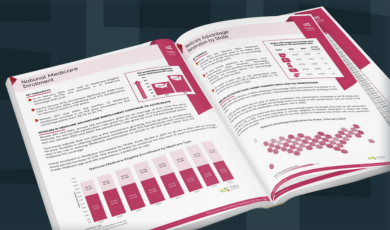Ashton Harrison, Marketing Engagement Manager
With a diverse background of sales and healthcare marketing, Ashton manages Trella’s events, press releases, and media and association relations. After graduating from Florida State University with a major in communications, she began her career at Greenway Health, a EHR company, where she found her passion for the healthcare industry. At Trella Health, she’s able to do all the things she loves about marketing — engaging at events, interactions with partners, and creating marketing pieces that share insight on Trella’s journey.4 Strategies for Creating a Competitive Advantage for Your Agency
By Ashton Harrison | March 26, 2021
Recently, Trella connected with partners at MedBridge and KanTime to discuss strategies post-acute agencies can use to set themselves apart from their competition. The importance of having a competitive edge increased significantly during the pandemic. Our speakers shared how they’ve seen top post-acute care organizations thrive during a challenging time by using innovative solutions, tools, and technology. If you missed the webinar, you can view it here.
Trella’s VP of Marketing, Jess Chew, shared her perspective and observations of how Trella Health customers have remained visible to referral partners. Adding in their unique insights, Kirsten Duell, Executive Vice President for KanTime, and Joe Brence, Head of Home and Community Care Strategy and Solutions for MedBridge, discussed how to drive major impact by focusing on things like team member training and simplifying the patient intake experience.
The speakers discussed four concepts in the webinar:
- Understanding your market landscape and its specific challenges
- Using technology to scale your business
- Taking a data-driven approach
- Optimizing the patient experience
Topic 1: Understanding your market landscape and its specific challenges
Jess kicked off this topic by sharing a few noteworthy findings from Trella’s 2020 Industry Trend Report:
- Medicare Advantage enrollees increased 9% year-over-year, and fee-for-service enrollees are decreasing. Medicare Advantage enrollees now make up about 40% of all Medicare beneficiaries
- Home health continues to be the top destination from an acute stay and narrowly edged out SNF as a top destination
- Hospice admissions remained stable, even during the pandemic, and the average length of stay increased by 1.6 days. The average is now 79.5 days
- Telehealth claims increased by 3334% year-over-year in April 2020
When looking at these trends, our panelists addressed the fact that, while adoption of new technologies was already on the rise, the pandemic dramatically escalated things like telehealth. Patients are likely to have new expectations for technology offerings moving forward. Another shift we see continuing is home health being a top destination and a higher demand for care at home, forcing a shift to the care model for hospitals and skilled nursing facilities. Lastly, Kristen noted how covid forced organizations to evaluate their technologies, and if they are not the best fit, what operational changes need to be made.
Topic 2: Using technology to scale your business
Jess noted the efficiencies your organization can gain by having the right technology in place and the positive impact it has on your staff and patient experience. She shared a personal story about a recent specialist visit. Despite being a part of her primary provider’s health system, the specialist did not have any of her medical information on file. It resulted in a very frustrating experience of paperwork and filling out information.
Kristen built on Jess’ story, explaining that this is a prime example of why there should be a focus on technology integration and interoperability. Technology is not meant to replace human intervention but should assist with efficiency and effectiveness. Organizations must think strategically about how their solutions are fitting together and interacting to benefit their patients and the employees who serve them. Here are Kristen’s top tips for implementing a new technology:
- User acceptance and adoption– Having the right technology is one part of the puzzle. But for it to be successful, you must also ensure your users understand how it will benefit them and the problem it solves. Bring your users into the decision-making process to keep them aware of adoption benefits.
- Timeliness– The time to process referral data, handle intake, clinical documentation, and bill for a visit is crucial. You need a system that is nimble and will keep up. Make sure your tools make it easy to swiftly move through the billing process so that you can easily predict cash flow.
- Market perception- Patient experience, reviews, and word of mouth can significantly impact the image others have of your organization. Your perception will be more positive if your team has the tools to optimize the patient experience.
Topic 3: Taking a data-driven approach
Joe kicked off this discussion by mentioning how MedBridge customers seek a data-driven approach to onboard new hires. COVID-19 forced a shift away from in-person classroom settings, favoring interactive technology instead. The payer shift toward more value-based payment type models is forcing agencies to innovate the quality care they provide and use data to identify which patients might be eligible for risk stratification. MedBridge has tackled this by creating bite-sized videos covering the quality indicators that you need to focus on.
Kristen followed up by stating, “If cash is king, then your data is like the castle that the king lives in.” Data is the foundation, and your metrics should provide insight into your business’s health from all perspectives. This data should range from clinical outcomes to referral business.
Jess emphasized how agencies need to be building personalized outreach to the people they want to connect with and that one of the most effective ways to do that is with data. Important data insights that can benefit your organization include a referral partner with the right patient mix, volumes, or competitor affiliations. Additionally, data on readmissions and specialty programs are great starting points for a meaningful conversation.
Topic 4: Optimizing the patient experience
Joe kicked this conversation off by stating that to optimize the patient experience, you must understand the shift in how patients are involved in their care planning as well as their interventions. Patients should be involved in making health care decisions and take control with preventive measurements. Leveraging interactive technology, like videos for at-home patient wound care, can also lead to more engagement and better patient outcomes. Kristen noted the importance of interaction and communication between clinicians and patients.
We received many great questions, like the ones below, that we answered live during the discussion:
Question 1: How do you make sure your teams provide the right customer service to patients and use that as a differentiator?
Jess: How you treat your staff will result in how they treat your customers or patients. Ensure that they feel enabled and empowered to do their jobs efficiently, effectively, and those positive experiences will then pass along to your patients. Additionally, every touchpoint your staff has with a customer or patient is part of their experience. It’s imperative to make sure that the people working the front desk, the intake process, and phones understand that they’re an essential part of the referral process.
Kristen: To be customer service oriented, you must think of your staff first. If you say you’re an employee-first organization, are you really aware of what your staff needs and the internal challenges? Look inward first with your business, resolve those problems, and it will positively impact your customer service.
Joe: In healthcare, we focus on the healthcare delivery and oftentimes miss the communication skills that our clinicians are providing. Do your clinicians have the skill set to de-escalate a situation in which a patient might be upset or angry? Clinicians should validate concerns of our patients and focus on soft skills that are often overlooked.
Question 2: Do you have any hospice technology programs that you would recommend in processing referrals, admissions, etc., to help with organizing details and gathering information that is easy to share among team members?
Kristen: I would recommend a solution that allows you to document within one system. With a solution like KanTime, you have cross-flow and care coordination and the ability to communicate effectively across your organization. You also want a technology company with partnerships, like the one between Trella, MedBridge, and Kantime, that utilize each other’s offerings.
Question 3: How to acquire more preferred Medicare referrals?
Jess: You need the market intelligence to understand who sees those most lucrative patients, who has the best-fit patients for your organization, and insight into who your top competitors are. Also, understanding your strengths and your competitors’ strengths, and how you can differentiate yourself. Lastly, you need to understand the market landscape. Who has the highest volumes of patients, who are the unaffiliated organizations, and who doesn’t seem to have preferred partnerships that you should start working with?
Question 4: Any words of encouragement on how to continue to handle the lower census of the skilled nursing facilities and lower hospice referrals?
Jess: Between the regulatory changes and PPE costs, we recognize what a hard year it has been for SNFs. The reduction in acute stays in skilled nursing facilities stays means there needs to an emphasis on building relationships in the community and with community physicians.
Kristen: Educate your community and referral sources, letting them know what you’ve done, what you’re doing for safety measures and train your team to be a resource for the families.
Joe: Understand the change in referral flow and how patients can be directly admitted to skilled nursing facilities in certain states from a home health agency. With this change, talk to partnered agencies or other post-acute providers and inform them when patients should be going back to a skilled nursing facility.
Want to learn more about how you can use technology to make your agency more competitive? Reach out to the Trella Health, Medbridge, or KanTime team today!













